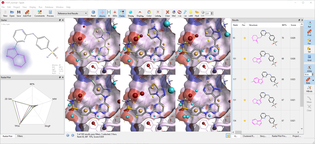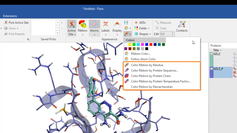March 2024 Newsletter
Welcome to the March Cresset newsletter where we share our latest results for GPCR benchmarks using Flare™ FEP, Cresset wins ...
News

With the upcoming release of Spark V10.6, Giovanna Tedesco, Head of Products, presents some of the new features in this bioisostere replacement tool, including the addition of a new docking functionality and improved calculation methods.

Explore the Appearance functionality in the latest version of our structure-based design platform, Flare, and learn how to view contacts between a protein and ligand.
We recently presented a poster on the validation of Free Energy Perturbation (FEP) techniques in Flare™ at the UK QSAR Autumn Meeting. As the meeting was conducted through a virtual format, the poster presented was abridged to aid legibility. See the full content where results obtained with Flare were broadly comparable to, or better than, previously published benchmarks for the standard FEP datasets.

This month we welcome Jenke Scheen, a PhD student at the University of Edinburgh, to the FEP team. Jenke's three month placement is a CASE studentship as part of our collaboration with Julien Michel's group at the University of Edinburgh.
Accurate predictions of relative binding affinities of ligands are becoming increasingly popular within the drug discovery community to help prioritize compounds for synthesis. In this webinar, we will give a brief introduction into Free Energy Perturbation (FEP) methods, and the pre-requisites needed to ensure a successful simulation. We will then show that by using the FEP functionality within Flare™, it is possible to use the GUI to design and run a simulation, and then analyze the subsequent results allowing the researcher to identify potential compounds for synthesis. Registration is open.
A business challenge facing chemistry teams is capturing ideas, prioritizing compounds for synthesis, planning and coordinating work allocation effectively, and delivering progress updates to the right people at the right time. This has been further complicated by COVID-19 induced disruptions, where research teams are now working in fragmented shift patterns or from remote locations. In this webinar, you will learn how to group and track compounds within design tickets, assign synthesis of single (or multiple) compounds to individuals, securely share selected compounds and contextual information with CRO partners, conduct collaborative exchanges, receive updates on changes to the designs and compounds in your project, and view detailed timelines of these status changes. In short, you will understand how easy it is to know the status of every project compound - in seconds. Registration is open.